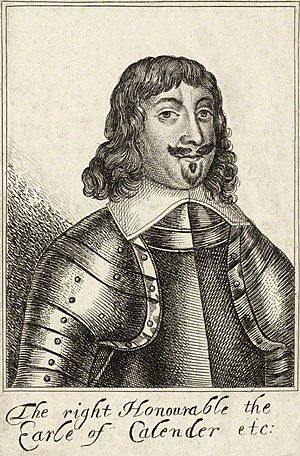James Livingston, 1st Earl of Callendar facts for kids
Quick facts for kids
The Earl of Callendar
|
|
|---|---|
 |
|
| Personal details | |
| Born | c. 1590s |
| Died | March 1674 |
| Spouses |
Hon. Margaret Seton
(after 1633) |
| Parents | Alexander Livingston, 1st Earl of Linlithgow Helenor Hay |
| Relatives | Andrew Hay, 8th Earl of Erroll (grandfather) William Livingstone, 6th Lord Livingston (grandfather) |
| Military service | |
| Allegiance | Royalists |
| Battles/wars | Bishops' War Second Bishops' War Second English Civil War |
James Livingston, 1st Earl of Callendar (born around the 1590s – died March 1674), was a Scottish army officer. He fought for the King's side, known as the Royalists, during a difficult time in history called the Wars of the Three Kingdoms.
Contents
Early Life of James Livingston
James Livingston was the third son of Alexander Livingston, 1st Earl of Linlithgow and Helenor Hay. He was likely born sometime in the 1590s. Around 1616, he began his military career. He became a lieutenant in the Dutch army, serving under his brother, Sir Henry Livingston.
A Soldier's Journey
By 1629, James Livingston was an experienced soldier. He held the rank of lieutenant-colonel in one of the Scottish regiments in the Dutch army. A few years later, in 1633, he became a full colonel. During this time, he also served both King James VI and King Charles I. For his service to the Crown, he received a pension and was made a knight.
In 1633, King Charles I visited Scotland. During this visit, James Livingston was given the title of Lord Livingston of Almond.
The Bishops' Wars
When the Bishops' War began, Livingston seemed to support the King at first. He backed a different agreement called the King's Covenant. However, he then said it also supported Presbyterianism, a type of church government. He claimed he needed to travel abroad for health reasons. This helped him avoid getting further involved in the war. Instead of returning to Scotland, he went to Holland and took command of his regiment there.
During the Second Bishops' War, Livingston served as a top general for the Covenanters' army. The Covenanters were a group who supported Presbyterianism in Scotland. He played a key role when the Scottish army invaded England. However, he disagreed with the policies of the Earl of Argyll. Livingston signed an agreement called the Cumbernauld Bond with others, including the Earl of Montrose. Even after this bond was discovered, Livingston kept his position as lieutenant-general.
Because Livingston supported the Covenanters, King Charles I asked for him to be removed from his Dutch army command. Later, during talks between the King and the Covenanters, Charles I tried to win Livingston over. He offered Livingston the important job of Treasurer of Scotland. But Livingston turned down the offer, choosing what he believed was best for the public over his own gain.
A Royalist Plan
Livingston was involved in a secret Royalist plan known as "The Incident". It was said that a plan to arrest the Earl of Argyll and the Marquess of Hamilton was discussed at Livingston's house. It was believed Livingston would have played a big part in these arrests. However, neither the King nor the Covenanters wanted to investigate too deeply, as they were close to reaching an agreement. As part of this agreement, Livingston was given the title of Earl of Callendar on October 6, 1641.
Livingston later refused a high position in the army raised by King Charles. Instead, he led a part of the Scottish forces into England in 1644. He helped Earl of Leven capture Newcastle-upon-Tyne. In 1645, Livingston left the army. He often felt that he was not treated with enough respect. In 1647, he helped promote "The Engagement". This was a plan to free King Charles I.
In 1648, the Scots marched into England during the Campaign of Preston. Livingston served as a top general under the Duke of Hamilton. But Hamilton found him difficult to work with, just as Leven had before. Livingston's advice was a main reason for the defeat at the Battle of Preston. After this battle, Livingston escaped to Holland. He was allowed to return to Scotland in 1650. However, in 1654, his lands were taken, and he was put in prison. He became important again when the monarchy was brought back during the Restoration.
Family and Later Life
In 1633, James Livingston married the Hon. Margaret Seton. She was the widow of Alexander Seton, 1st Earl of Dunfermline. Margaret was the sister of John Hay, 1st Earl of Tweeddale. She was also the only daughter of James Hay, 7th Lord Hay of Yester and Lady Margaret Kerr.
James Livingston passed away in March 1674. He did not have any children. Because of a special rule, his nephew, Alexander Livingston, became the next Earl of Callendar. Alexander was the second son of Alexander Livingston, 2nd Earl of Linlithgow.

